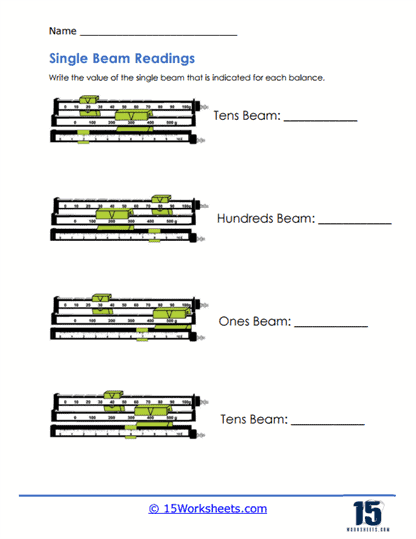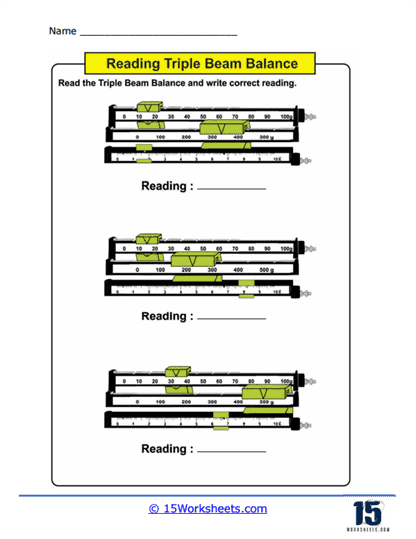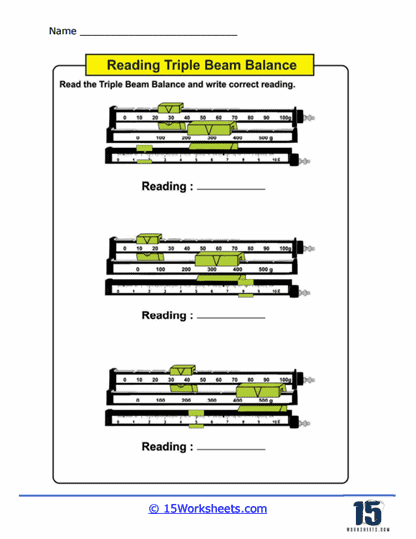Triple Beam Balance Worksheets
About These 15 Worksheets
These worksheets were created to help students learn how to measure the mass of objects using a triple beam balance. These worksheets are commonly used in science and math classes, particularly in middle and high school settings, to enhance students’ understanding of mass measurement and improve their practical skills in using this type of balance scale.
A triple beam balance is a type of scale that has three beams, each with a sliding weight. As students move these weights to find the balance point, they determine the mass of the object placed on the scale’s pan. Triple Beam Balance Worksheets provide exercises that guide students through the process of using these scales, interpreting results, and applying this knowledge in various scientific contexts.
They offer a blend of diagram labeling, practical measuring exercises, application scenarios, theoretical questions, and review activities to ensure a thorough understanding of how mass is measured and applied in scientific contexts. Through these varied exercises, students develop practical skills, enhance their problem-solving abilities, and gain a deeper understanding of fundamental scientific principles.
Types of Exercises On These Worksheets
Labeling Diagrams – Students are provided with a blank diagram of a triple beam balance and asked to label parts such as the beams, weights, pan, and pointer. This helps students familiarize themselves with the terminology and physical layout of the device.
Multiple Choice Questions – These questions test students’ understanding of the function of each part of the balance. For example, questions might ask which beam has the smallest weights or what the purpose of the pointer is.
The core of Triple Beam Balance Worksheets consists of practical exercises that simulate the use of a physical triple beam balance:
Measuring Objects – Students are given a list of virtual objects with specified masses. They must determine the correct placement of the weights on the beams to balance each object’s mass. This can include step-by-step instructions to guide beginners on how to adjust the weights properly.
Reading Measurements – After a hypothetical measurement setup is described, students may be asked to read and record the mass based on the positions of the weights. This exercise reinforces their ability to interpret the scale readings accurately.
Calculating Total Mass – In more advanced worksheets, students might be tasked with calculating the total mass of multiple objects placed on the balance at once, requiring them to add the individual masses calculated from different weight settings.
Problem Solving – Students might be presented with a scenario where they need to figure out if a given object can float on water based on its density and mass. They would use the balance to determine the mass and then calculate density using the formula density = mass/volume.
Experiment Data Recording – In this type of exercise, students use a triple beam balance as part of a larger experiment, such as measuring the mass of chemical compounds before and after a reaction. Worksheets guide them on how to record and analyze this data.
To complement the practical components, Triple Beam Balance Worksheets may also include theoretical exercises that focus on the principles underlying mass measurement:
Conversions and Units – Exercises may require students to convert measurements between different units (e.g., grams to kilograms) or solve puzzles using these conversions.
Understanding Precision – Students might explore how the precision of a triple beam balance compares with other types of scales and discuss the importance of precision in scientific measurements.
Historical Context – Some worksheets include a section on the history and development of the triple beam balance, helping students appreciate its role in scientific advancements.
Error Analysis – Exercises might also ask students to identify potential errors in measurement and suggest ways to minimize these errors, enhancing their critical thinking and analytical skills.
What are Triple Beam Balances?
The triple beam balance is characterized by its three adjustable beams, each with a sliding weight, known as riders. These beams are graduated in different increments, allowing for precise measurements. The first beam typically measures in grams, the second in ten-gram increments, and the third in hundred-gram increments. This setup enables it to measure very light objects with high precision as well as relatively heavy objects with satisfactory accuracy.
Uses in the Real World
In the real world, triple beam balances are indispensable in environments where precision in mass measurement is crucial but where electronic scales might not be practical due to environmental factors or the need for calibration. They are commonly found in:
Educational Settings – Schools and universities use them in science classes, particularly in chemistry and physics labs, to teach students about mass, weight, and the principles of balancing. They are ideal for hands-on learning and experiments where students need to measure various substances and items.
Laboratories – Many scientific laboratories prefer triple beam balances for tasks requiring precise measurements of chemical substances before they are combined in experiments. They are particularly useful in environments where electrical instruments might interfere with sensitive measurements.
Industrial Applications – Certain industries require precise weight measurements of small items, such as in the manufacturing of mechanical components or in the culinary industry for measuring ingredients.
Pharmaceuticals – In pharmacies, especially those preparing specific dosages of medications on-site, triple beam balances help in measuring small, precise amounts of various compounds.
How to Use a Triple Beam Balance
Using a triple beam balance involves several steps, each requiring careful attention to ensure accuracy:
Setting Up – Place the balance on a flat, stable surface to ensure accurate readings. Before using, ensure that the balance is calibrated. You start by making sure all weights are at zero, and the balance pointer aligns with the zero mark on the scale. If it doesn’t, you’ll need to adjust the zero point using the calibration knob.
Placing the Object – Place the object whose mass you want to measure on the pan, ensuring it is centered.
Adjusting the Weights – Begin with the largest weight on the furthest beam. Slide this weight along the beam until the arm drops below the balance point. Move it back to the last position where it was balanced, then proceed to the next largest weight. Continue this process using the middle beam, and then with the smallest beam, adjusting each weight until the balance arm is level.
Reading the Mass – Once the balance arm is level, read the mass indicated by the position of each rider on their respective beams. Add these numbers together to obtain the total mass of the object.
Double-Checking – It’s often a good practice to repeat the measurement to ensure accuracy, particularly if the results are critical to further calculations or experiments.
Recording the Measurement – Once verified, record the mass as needed for your experiment, calculation, or record-keeping.
The use of a triple beam balance not only provides accurate measurements but also imparts a deeper understanding of the principles of mass and weight. It requires a manual interaction that digital devices bypass, offering an invaluable educational experience in precision and meticulousness.
















